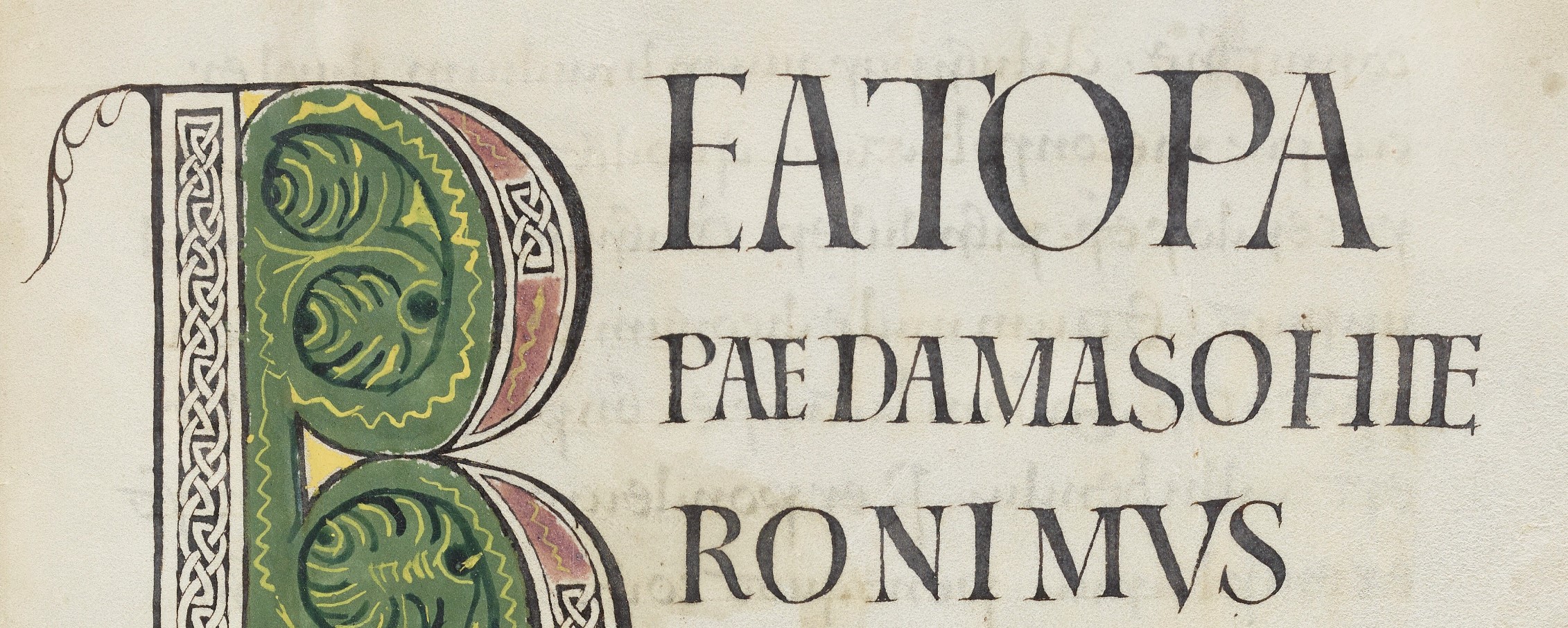Oxford, Bodleian Library, MS. Laud Lat. 102, a Gospel book written in the early 800s, is one of the oldest manuscripts to be included in the Polonsky German project. The manuscript is typical of Gospel books from this period: it begins with a set of ‘Canon tables’ – charts that show how the different narrative elements correspond across the Gospels – followed by a series of prefaces and the Gospels of Matthew, Mark, Luke, and John. As is the case with many manuscripts from this period, MS. Laud Lat. 102 was written by several different scribes, working together in a monastic scriptorium. The variety of these scripts make MS. Laud Lat. 102 an important record of a critical time of transition and innovation in Europe, at the onset of the Carolingian era.
Oxford, Bodleian Library, MS. Laud Lat. 102, fol. 12r
The hand of the first scribe may be difficult to read if you haven’t studied it before. Some of the letterforms are quite different from those we are used to today, such as the flat-topped [g], the [a] that looks like a [u], and the long, spikey [r] and [s] (pro-tip: [r] has an arc that curves down to the line of writing, while the arc of the [s] is shorter). All of these forms can be seen in this detail, in the word ‘sacrilegum’.

Another significant feature is the letter [e], which has two forms: one that looks like a modern lower-case [e], and a tall form that looks almost like a majuscule. The latter is used before the letters [m], [n], [r], [s], and [t] (all of those letters have a short horizontal stroke at the left that does double-duty as the central crossbar of the [e]). If you have studied Latin palaeography, you might look at this page and conclude that the manuscript was written in the British Isles. It’s quite similar to, for example, Oxford, Bodleian Library, MS. Hatton 93, a fragment of a manuscript written in England around the same time. You’d be justified in thinking that MS. Laud Lat. 102 might be from England as well.
But you’d be wrong: the manuscript was written on the continent, in the Benedictine abbey of St Salvator in Fulda, Germany.
Because both of these digitizations are IIIF-compliant, the image sets can be easily mirrored side-by-side in a shared-canvas viewer for easy comparison.
Why would such a stereotypically insular script be written in a German monastery? To answer that question, we have to look back another hundred years.
By the early eighth century, missionaries from English and Irish monasteries had begun fanning out across the continent establishing monastic houses. Fulda, for example, was founded in 744 by St Sturm, a disciple of the English saint Boniface. The new monastic libraries were seeded with manuscripts brought from the British Isles, manuscripts that were written using the insular script styles of their scriptoria. When monks at the newly established monasteries started making copies of these foundational texts, they used those styles as well. In addition, monks who relocated from Britain to the new continental abbeys continued to write in the style in which they had been trained.
By the early ninth century, when MS. Laud Lat. 102 was written, these abbeys were firmly established. It was a period of consolidation, reform, and renewal, embodied by Charlemagne, Holy Roman Emperor and King of France. As part of a campaign to help unify this vast realm, the letterset known as Caroline minuscule was developed and its use encouraged at scriptoria throughout the continent. The story is a bit more complicated, of course, but that’s the short version.
What makes MS. Laud Lat. 102 so interesting is that some of the scribes used the old insular style while others used the newer style. As you turn the page from fol. 59r to 59v, when one of the Caroline-style scribes takes over, you are actually seeing this important transition take place.
Oxford, Bodleian Library, MS. Laud Lat. 102, fol. 59r
It’s no coincidence that the Caroline letterforms on fol. 59v look more familiar to you – a modern reader – than do their insular antecedents. The Latin alphabet used today – indeed, the very font in which this blog is set – is a direct descendent of Caroline Minuscule (by way of the Renaissance humanists, but that’s a story for another day). The transition from insular to Caroline was underway in early ninth-century Fulda, but some scribes at the Abbey hadn’t mastered – or didn’t want to learn – the new alphabet. By the time Fulda manuscripts like this one were written in the middle of the ninth century, the insular style had been abandoned and the Caroline takeover was complete.
About the author
Lisa Fagin Davis is a palaeographer, codicologist, fragmentologist, and blogger, and is mother to two humans and a beagle. She has been Executive Director of the Medieval Academy of America since 2013.
Bibliography
Daniela Mairhofer, Medieval Manuscripts from Würzburg in the Bodleian Library, Oxford: A Descriptive Catalogue (Oxford, 2014), pp. 264–74.
